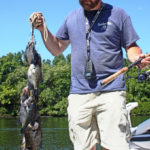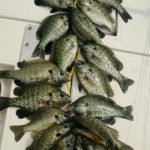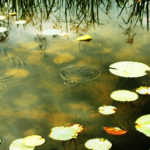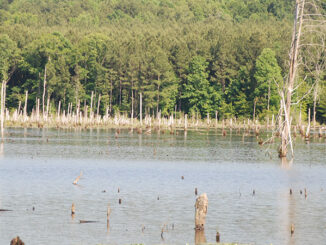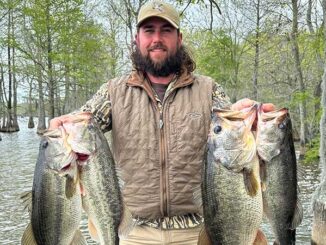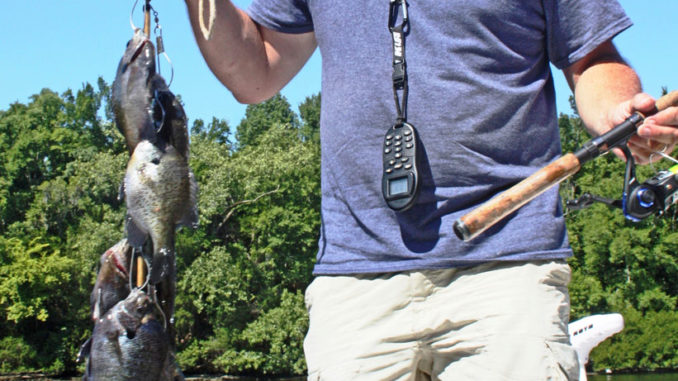
April is time for all kinds of panfish at Santee
The flooded cypress and gum tree forests and the abundance of shallow vegetation of Santee Cooper is Ground Zero for some of the best panfish action in South Carolina. Bull bream and super-sized shellcrackers abound, and anglers armed with the basic techniques of how, when and where to fish for this dynamic duo have an opportunity to limit on either species or a combination of both.
Depending on the moon phase, both species will be spawning during April, but limits of big panfish are caught whether bedding or not.
Guide Joe Dennis, who targets both species, said the key this month is to work shallow water, fishing grass and tree targets with a long pole.
“I believe in staying on the move looking for panfish,” Dennis said. “Both species will be holding around shallow cover, and if I’m targeting bream, I use crickets, but if focusing on shellcrackers, I’ll primarily use red worms. But either will catch both species. I’ll use crickets as my default bait of choice as I work around trees, grass beds, pads, brush and stumps. But I’ll typically have plenty of both with me on most days.”
Dennis (843-245-3762) said his favorite tactic is to move quietly through the shallows and simply hunt the fish down. He employs an electric motor to move his boat through the maze of trees and vegetation and works the bait next to any object they see. If everything looks fishy, that’s because it frequently is.
Dennis’s basic rig is an 8- to 10-foot, light-action pole rigged with 10-pound line that’s slightly longer than the pole. He uses a No. 4 wire hook, a small float and a split-shot to complete the rig. The float is a small cork with a hole through the middle with a toothpick line stopper, making changing the depth you’re fishing quick and easy.
“I typically begin in about 3 feet of water and work both shallower and deeper until we catch a few fish and get the feel for the daily pattern,” he said. “It’s not unusual for everyone to see a prime looking spot and multiple corks surround the target. This is fine, because sometimes everyone hooks a big bream or shellcracker immediately. This is no time to be shy; often, a tiny spot holds multiple fish so everyone works that target until the fishing slows and we move on.”
“If the water is clear, using polarized glasses help fishermen actually see the beds,” he said. “That’s a great way to find a bed but not the only way.”
Bait and switch
Dennis has learned that if he catches a shellcracker while fishing with a cricket, he’ll immediately back off the spot and get worms on the hooks to probe for more shellcrackers. Where he finds one, often many more are nearby.
“That’s frequently how I locate shellcracker beds,” he said. “Another thing I watch for is a strange bite. Bream usually bite crickets aggressively, so if I get a passive, lethargic bite and don’t hook the fish, I immediately think shellcracker. I drop the rig back in the same spot, but with a red worm on the hook, and often, a big shellcracker immediately loads on. Their preference is red worms, and they’ll bite worms aggressively.”
Dennis said this panfish-probing tactic is similar to bass fishing; once he gets a pattern for the day for bream or shellcracker, he can refine his search to specific areas. Some days, big bream may be holding primarily on the outside trees of cypress tree clumps, and at other times, they prefer isolated trees. The same is true for shellcrackers, with logs, stumps and weedbeds on sandy bottoms being good bets for targeting them.
“The best part of this mobile style of fishing is that we’ll usually enjoy good action throughout the day,” he said. “Plus, we can usually begin culling fairly early, keeping some really big bream and shellcracker.”
Dennis said although he stays mobile searching for fish, he’ll give an area a reasonable time to produce. When he works into an area with small openings in dense clusters of trees, he’ll patiently work the edges and the scattered stumps and other cover, places many anglers pass by.
“A single tree, downed log or even a single stump in the opening can hold a pile of fish,” he said. “If I catch a bunch of fish in a specific area, I’ll return later in the day and usually catch more fish. Whatever attracts fish to a specific place that day will pull more fish if you let it rest and quietly sneak back.”
Dennis said it crucial to get the bait tight to cover, a big reason he likes the long pole over spinning or spincast rigs.
“It’s simply a process of working the cover thoroughly,” he said. “Most anglers are surprised at how many fish they’ve caught, steadily catching two or three from a spot and the occasional hot spot producing several fish. And that’s the fun of April panfishing at Santee Cooper.”

